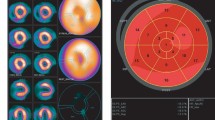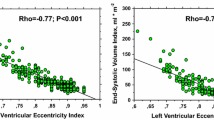Abstract
Rest myocardial 201Tl scintigraphy was undertaken in 15 males mean age 39 years (22–54) who had been accepted for cardiac transplantation. Complete pathological correlation was obtained in 14 after transplantation and in 1 who died before a suitable donor heart became available. The average time from scintigraphy to pathological evaluation was 42 days (9–103). All the 201Tl images were grossly abnormal and on the basis of these studies it was not possible to differentiate ischemic from idiopathic cardiomyopathy. Each of the three views of the 201Tl study was divided into three segments, therefore 135 areas were available for comparison (3×3×15). Eighty-eight of these were abnormal on scan and 78 of these were abnormal pathologically. The right ventricle was seen on all rest images but the degree of uptake bore no relationship to the measured thickness of the right ventricular wall. Structures such as the atrial wall and the enlarged papillary muscle were visualized in some patients. In two patients there was an improvement of the rest 201Tl image in delayed views and histologically these areas showed a mixture of muscle and fibrous tissue. The sensitivity of 201Tl imaging in this study was 89% and there was close correlation of the images with gross and microscopic pathological findings.
Similar content being viewed by others
References
Adachi H, Torii Y, Kamide T, Katsume H, Ochiai M, Ijichi H (1980) Visualization of right atrial appendix by Thallium-201 myocardial scintigraphy. Concise communication. JNM 21:914–918
Bailey LK, Griffith LSC, Rouleau J, Strauss HW, Pitt B (1977) Thallium-201 myocardial perfusion imaging at rest and during exercise — Comparative sensitivity to electrocardiography in coronary artery disease. Circulation 55:79–87
Berger BC, Watson DD, Burwell LR, Crosby IK, Wellons HA, Teates CD, Beller GA (1979) Redistribution of thallium at rest in patients with stable and unstable angina and the effect of coronary artery bypass surgery. Circulation 60:1114–1125
Cohen HA, Baird MG, Rouleau JR (1976) Thallium-201 myocardial imaging in patients with pulmonary hypertension. Circulation 54:790–795
Cowley MJ, Coghlan HC, Logic JR (1977) Visualization of atrial myocardium with thallium-201. JNM 18:984–986
Gewirtz H, Beller GA, Strauss HW, Dinsmore RE, Zir LM, McKusick KA, Pohost GM (1979) Transient defects of resting thallium scans in patients with coronary artery disease. Circulation 59:707–713
Goris ML, Daspit SG, McLaughlin P, Kriss JP (1976) Interpolative background subtraction. JNM 17:744–747
Khaja F, Alam M, Goldstein S (1979) Diagnostic value of visualization of the right ventricle using thallium-201 myocardial imaging. Circulation 59:182–188
Kondo M, Kubo A, Yamazaki H, Ohsuzu G, Handa S, Tsugu T, Masaki H, Kinoshita F, Hashimoto S (1978) Thallium-201 myocardial imaging for evaluation of right-ventricular overloading. JNM 19:1197–1203
Massie BM, Botvinick EH, Brundage BH (1979) Correlation of thallium-201 scintigrams with coronary anatomy: Factors affecting region by sensitivity. Am J Cardiol 616–622
McKillop JH, Murray RG, Bessent RG, Turner JG, Greig WR, Lorimer AR (1979a) The significance of the abnormal rest thallium-201 myocardial image in coronary artery disease. Eur J Nucl Med 4:83–86
McKillop JH, Murray RG, Turner JG, Bessent RG, Lorimer AR, Greig WR (1979b) Can the extent of coronary artery disease be predicted from thallium-201 myocardial images. JNM 20:714–19
McKillop JH, Fawcett HD, Baumert JE, McDougall IR, DeBusk RF, Harrison DC, Goris ML (1981) ECG gating of thallium-201 myocardial images. Effect on detection of ischemic heart disease. JNM 22:219–225
Pohost GM, Fallon JT, Strauss HW (1979) Radionuclide techniques in cardiomyopathy in cardiovascular nuclear medicine, 2nd edn. Strauss HW, Pitt B (eds) CV Mosby, St Louis, pp 326–340
Ritchie JL, Trobaugh GB, Hamilton GW, Gould KL, Narahara KA, Murray JA, Williams DL (1977) Myocardial imaging with thallium-201 at rest and during exercise-Comparison with coronary arteriography and resting and stress electrocardiography. Circulation 56:66–71
Turner DA, Battle WE, Desmukh H, Colandrea MA, Snyder GJ, Fordham EW, Messer JV (1978) The predictive value of myocardial perfusion scintigraphy after stress in patients without previous myocardial infarction. JNM 19:249–255
Wackers FJTh, Becker AE, Samson G (1977) Location and size of acute transmural myocardial infarction estimated from thallium-201 scintiscans — A clinicopathological study. Circulation 56:72–78
Author information
Authors and Affiliations
Additional information
J.H. McKillop is a Harkness Fellow of the Commonwealth Fund
Rights and permissions
About this article
Cite this article
McKillop, J.H., Billingham, M., Schroeder, J.S. et al. Correlation of an abnormal rest 201Tl myocardial image: Pathological findings in cardiac transplant recipients. Eur J Nucl Med 7, 243–247 (1982). https://doi.org/10.1007/BF00251474
Received:
Issue Date:
DOI: https://doi.org/10.1007/BF00251474




